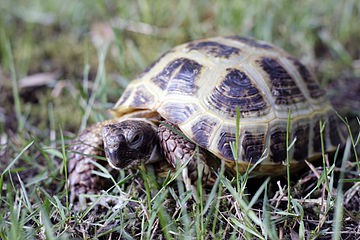Type the name of the breed you're looking for below
[wpdreams_ajaxsearchlite] Don't see the breed your're looking for? Click here and let us know!
Russian Tortoise
| Place of Origin and Range | The Russian tortoise, Horsfield's tortoise or Central Asian tortoise Agrionemys horsfieldii, is a species of tortoise and a popular pet. The species is named after the American naturalist Thomas Horsfield. |
| Description | Russian tortoises are sexually dimorphic. Males tend to have longer tails generally tucked to the side; females have a short, fat tail. The male has a slit-shaped vent (cloaca) near the tip of its tail; the female has an asterisk-shaped vent (cloaca). Russian tortoises have four toes. Colouration varies, but the shell is usually a ruddy brown or black, fading to yellow between the scutes, and the body is straw-yellow and brown. |
| Morph Patterns Available | Yes |
| Adult Size | Can grow up to 10 in(25 cm) |
| Accommodation | Arid Rocky or savannah habitat. To avoid injuries anchor any rocks in the vivarium before you add the substrate. In this case sand. You will want to include a large dish for bathing and soaking in to improve shedding. Always include a day basking spot at 80'F(27'C). Along with multiple hides. Minimum 2 x 8 feet for an adult. |
| Lifespan | Can live 10+ years |
| Feeding / Diet | This tortoise is an omnivore, with a very varied diet consisting mainly of a range of different plants, but also including insects and other meat. It feeds on vegetables, twigs, roots, leaves, fruits, earthworms, snails, tadpoles and other small invertebrates. |
| Breeding | The male Russian tortoise courts a female through head bobbing, circling, and biting her forelegs. When she submits, he mounts her from behind, making high-pitched squeaking noises during mating. |



